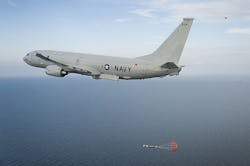Navy asks Northrop Grumman to provide LAIRCM laser-based missile-defense systems for large aircraft
PATUXENT RIVER NAS, Md. – Missile-defense experts at Northrop Grumman Corp. will install LAIRCM laser-based missile-defense systems for large military aircraft under terms of a $210.5 million U.S. Navy order announced Thursday.
Officials of the Naval Air Systems Command at Patuxent River Naval Air Station, Md., are asking engineers at the Northrop Grumman Mission Systems segment in Rolling Meadows, Ill., to provide the electro-optical Large Aircraft Infrared Counter Measures (LAIRCM) for a variety of U.S. military aircraft.
LAIRCM automatically detects a missile launch, determines if it is a threat, and activates a high-intensity laser-based countermeasure system to track and defeat the missile, Northrop Grumman officials say.
This order covers LAIRCM production for the U.S. Navy, Air Force, Army, Special Operations Command, and government of the United Kingdom.
Related: Electro-optical sensors key to missile defense
The system is for large aircraft like the U.S. Navy P-8A Poseidon maritime patrol jet and the Marine Corps CH-53 Super Stallion large helicopter. LAIRCM also can go aboard the U.S. Air Force C-5, C-17, C-37, and C-40 cargo and utility jets; C-130H and MC-130W four-engine utility turboprop aircraft, the CV-22 tiltrotor aircraft, and the KC-46 aerial refueling jet.
The order involves 466 advanced threat warning sensors; 15 LAIRCM signal processor replacements; 30 control indicator units; 62 replaceable control indicator units; 114 to 2,103 signal processors; 161 infrared missile warning sensors; 245 Guardian laser transmitter assemblies; 20 multi-role electro-optical end-to-end test sets; 125 shipping containers; 56 high-capacity cards; 16 smart connector assemblies; 381 personal computer memory cards; international association cards; and 11 battery kits.
LAIRCM focuses its high-intensity laser energy at the infrared seeker head of incoming missiles to blind the missile and force it off its target. The system is designed to protect large aircraft from shoulder-fired, vehicle-launched, and other infrared-guided missiles when the planes are operating close to the ground, such as during takeoffs, landings, and low-level operations like aerial refueling.
Initial LAIRCM systems equipped C-17 and C-130 aircraft as a stop-gap measure, using an ultraviolet sensor, a countermeasure processor, and a small laser turret assembly.
Later-model LAIRCM systems use a smaller laser turret, and operate in the infrared region. Compared to first-phase LAIRCM systems, the newer models provide better resolution, better performance in optical clutter, and increased range of detection.
In the future military leaders are trying to develop aircraft-protection infrared countermeasures able to detect and classify incoming missiles, then emit a custom jamming energy to defeat them.
On this order Northrop Grumman will do the work in Rolling Meadows, Ill.; Goleta, Calif.; Longmont, Colo.; Colombia, Md.; and at various locations within and outside of the continental U.S., and should be finished by October 2020.
For more information contact Northrop Grumman Mission Systems online at www.northropgrumman.com, or Naval Air Systems Command at www.navair.navy.mil.
Ready to make a purchase? Search the Military & Aerospace Electronics Buyer's Guide for companies, new products, press releases, and videos

